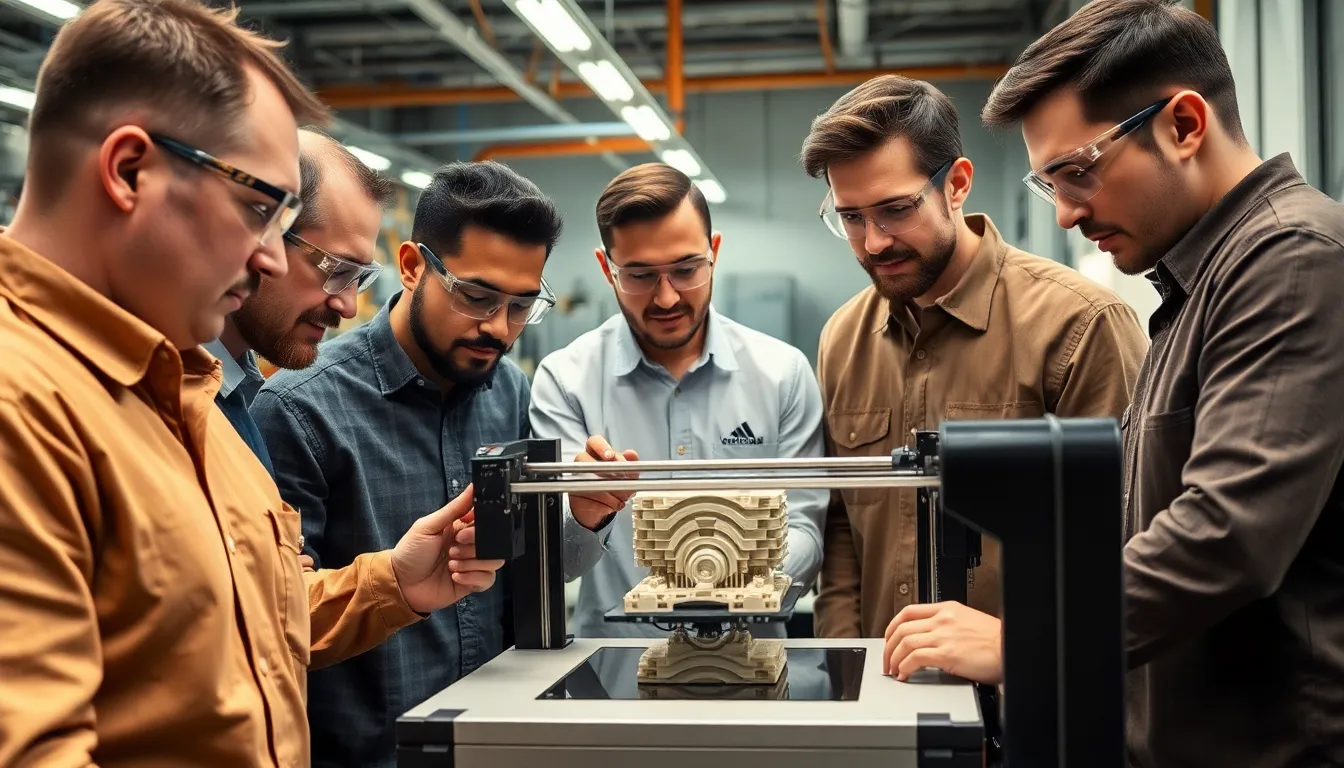In a world where robots might just take over your job but also make your life a whole lot easier, advanced manufacturing technology is the unsung hero of modern industry. Picture this: machines that can think, adapt, and even outsmart their human counterparts—sounds like a sci-fi movie, right? But it’s real, and it’s revolutionizing how products are made, from cars to smartphones.
With innovations like 3D printing and AI-driven processes, manufacturers are cranking out goods faster than you can say “supply chain optimization.” This isn’t just about efficiency; it’s about creativity and customization that would make even the most imaginative artists jealous. So buckle up, because advanced manufacturing technology is not just changing the game; it’s rewriting the rules.
Table of Contents
ToggleOverview of Advanced Manufacturing Technology
Advanced manufacturing technology encompasses a range of cutting-edge techniques and processes that significantly enhance production capabilities. Innovations such as 3D printing, robotics, and artificial intelligence drive efficiency and flexibility in manufacturing operations.
3D printing permits the creation of intricate designs and customized products, which traditional manufacturing methods struggle to achieve. CAD (Computer-Aided Design) software allows engineers to develop detailed digital models before production begins, streamlining the design process.
Robotics plays a crucial role by automating repetitive tasks, thereby reducing human error and increasing output. Various industries employ robotic systems for assembly, packaging, and quality control, leading to faster production times.
AI-driven processes bolster decision-making by analyzing vast amounts of data and identifying patterns. Companies utilize AI algorithms to optimize supply chains and predictive maintenance. This approach minimizes downtime and improves resource allocation.
Additive manufacturing broadens the scope of material usage, permitting manufacturers to explore new possibilities and reduce waste. Companies experiment with metals, plastics, and composites to create lightweight yet durable components.
Integration of IoT (Internet of Things) devices enhances real-time monitoring and communication on the factory floor. Sensors and connected machines offer insights into equipment performance and operational efficiency, enabling swift adjustments as needed.
By embracing these advanced manufacturing technologies, industries can customize products to meet consumer demands more effectively. Significant shifts occur in how products are designed, produced, and delivered, leading to sustainable growth and competitive advantages.
Key Technologies in Advanced Manufacturing

Advanced manufacturing leverages several key technologies to revolutionize production processes. These technologies enhance efficiency, precision, and customization.
Additive Manufacturing
Additive manufacturing, often known as 3D printing, builds components layer by layer. This method allows for intricate designs that traditional fabrication can’t achieve. Industries like aerospace, healthcare, and automotive utilize this technology to create complex geometries. By reducing waste and enabling rapid prototyping, additive manufacturing accelerates the product development cycle. It supports customization for niche markets, driving innovation in product offerings.
Robotics and Automation
Robotics and automation streamline production lines across several sectors. Robots handle repetitive tasks, improving consistency and increasing output rates. By integrating machine learning, robots adapt to new tasks with minimal downtime. This flexibility enhances workforce efficiency while reducing operational costs. Manufacturers implement collaborative robots to work alongside personnel, promoting safer and more efficient environments.
Internet of Things (IoT) Integration
IoT integration enhances real-time monitoring and decision-making capabilities. Connected devices collect data from various points along the production chain. This connectivity enables proactive maintenance, reducing machine downtime and extending equipment lifespan. Manufacturers benefit from data-driven insights that optimize resource allocation and improve supply chain management. By embracing IoT, companies position themselves for greater operational efficiency and competitiveness.
Benefits of Advanced Manufacturing Technology
Advanced manufacturing technology delivers numerous advantages across various industries. Significant improvements in efficiency, cost management, and quality control emerge as key benefits.
Increased Efficiency
Increased efficiency characterizes advanced manufacturing processes. Automation reduces processing times, enabling faster production cycles. Robotics handle repetitive tasks consistently, preventing human error and output variability. Additionally, adaptive machines optimize their operations in response to real-time data. Speedy prototyping occurs through additive manufacturing, allowing for swift iterations and adjustments. Data from IoT devices informs decisions, leading to streamlined workflows. The cumulative effect fosters enhanced productivity, thereby maximizing resource use.
Cost Reduction
Cost reduction results from implementing advanced manufacturing technologies. Savings arise as automation cuts labor expenses and increases output rates. Additive manufacturing minimizes material waste, contributing to lower production costs. Streamlined supply chain management enables manufacturers to optimize inventory levels and reduce overstock scenarios. Predictive maintenance techniques prevent major equipment failures, saving on repair costs and downtime. Overall, these innovations positively impact profit margins, allowing for more competitive pricing in the marketplace.
Enhanced Quality Control
Enhanced quality control defines the outcomes of advanced manufacturing methods. Continuous monitoring systems track production processes, identifying potential quality issues early. Automation ensures consistency, maintaining high standards across all manufactured products. Advanced analytics provide insights into defects, helping manufacturers refine processes effectively. Inspections through machine learning algorithms enable quicker, more accurate quality assessments. This proactive approach to quality boosts customer satisfaction and strengthens brand reputation.
Challenges in Implementing Advanced Manufacturing Technology
Implementing advanced manufacturing technology presents specific challenges that organizations must navigate. These include high initial investments and the need for a skilled workforce.
High Initial Investment
Adopting advanced manufacturing technologies often involves significant capital expenditures. Equipment costs for robotics, 3D printers, and IoT devices can quickly accumulate. For instance, a single industrial robot can cost anywhere between $25,000 and $400,000 depending on its functionalities. Furthermore, infrastructure upgrades may add more financial strain. Organizations should also factor in the expenses associated with training employees on new systems and integrating technology into existing processes. As a result, companies must evaluate the return on investment carefully to justify these upfront costs before moving forward.
Skilled Workforce Requirements
A crucial aspect of advanced manufacturing technology is the requirement for a skilled workforce. Employees need specialized training to operate sophisticated machinery and software systems effectively. For example, knowledge of programming languages and data analysis plays a vital role in optimizing production. Many organizations encounter challenges in finding workers with the necessary skill sets. The gap in technical expertise often complicates hiring processes and can slow down implementation timelines. Investing in employee training and development becomes essential to address this skill shortfall and ensure operational efficiency.
Future Trends in Advanced Manufacturing Technology
Advanced manufacturing technology is evolving at a rapid pace, shaping the future of production. Key trends are emerging that promise to redefine industry standards.
Industry 4.0 Revolution
Industry 4.0 embodies the fusion of digital technology and manufacturing. Factories leverage IoT, big data, and AI to enhance efficiency and decision-making. Automation gains momentum through smart machines that communicate in real-time, creating interconnected production environments. Data analytics extracts insights, informing strategies for predictive maintenance and resource optimization. Companies benefit from increased flexibility, allowing rapid adaptation to market demand changes. Enhanced connectivity fosters collaboration across supply chains, streamlining processes and reducing lead times. Overall, the Industry 4.0 revolution creates a data-driven ecosystem that supports innovation and drives competitiveness.
Sustainability and Eco-Friendly Practices
Sustainability in manufacturing becomes imperative as industries prioritize eco-friendly practices. Advanced technologies like additive manufacturing reduce material waste through precise production methods. Renewable energy sources power factories, minimizing their carbon footprint. Circular economy principles encourage resource reuse and recycling, enhancing sustainability. Manufacturers are investing in green supply chains, choosing sustainable materials and reducing emissions. Innovations in energy-efficient machinery also contribute to lower environmental impact. As consumer demand for sustainable practices rises, companies integrating eco-friendly strategies position themselves favorably in the market. Collectively, these initiatives promote a more sustainable future for manufacturing.
Advanced manufacturing technology is reshaping the industrial landscape in profound ways. By leveraging innovations like 3D printing, robotics, and AI, manufacturers are not only boosting efficiency but also enhancing creativity and customization. This evolution fosters a more agile production environment capable of meeting diverse consumer needs.
As industries navigate the challenges of high initial investments and the demand for skilled labor, the benefits of adopting these technologies become increasingly clear. The future of manufacturing lies in embracing these advancements while prioritizing sustainability and resource efficiency. Companies that adapt to this new paradigm will not only thrive but also contribute to a more sustainable and innovative manufacturing ecosystem.



